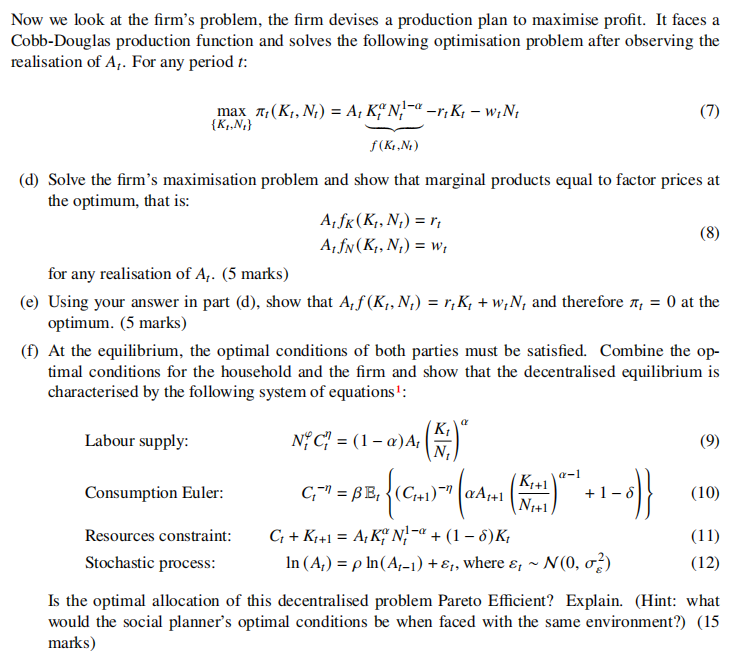
Now we look at the firm's problem, the firm devises a production plan to maximise profit. It faces a Cobb-Douglas production function and solves the following optimisation problem after observing the realisation of At. For any period t : max{Kt,Nt}t(Kt,Nt)=Atf(Kt,Nt)KtNt1rtKtwtNt (d) Solve the firm's maximisation problem and show that marginal products equal to factor prices at the optimum, that is: AtfK(Kt,Nt)=rtAtfN(Kt,Nt)=wt for any realisation of At. (5 marks) (e) Using your answer in part (d), show that Atf(Kt,Nt)=rtKt+wtNt and therefore t=0 at the optimum. (5 marks) (f) At the equilibrium, the optimal conditions of both parties must be satisfied. Combine the optimal conditions for the household and the firm and show that the decentralised equilibrium is characterised by the following system of equations 1 : Labour supply: NtCt=(1)At(NtKt) Consumption Euler: Ct=Et{(Ct+1)(At+1(Nt+1Kt+1)1+1)} Resources constraint: Ct+Kt+1=AtKtNt1+(1)Kt Stochastic process: ln(At)=ln(At1)+t, where tN(0,2) Is the optimal allocation of this decentralised problem Pareto Efficient? Explain. (Hint: what would the social planner's optimal conditions be when faced with the same environment?) (15 marks) Now we look at the firm's problem, the firm devises a production plan to maximise profit. It faces a Cobb-Douglas production function and solves the following optimisation problem after observing the realisation of At. For any period t : max{Kt,Nt}t(Kt,Nt)=Atf(Kt,Nt)KtNt1rtKtwtNt (d) Solve the firm's maximisation problem and show that marginal products equal to factor prices at the optimum, that is: AtfK(Kt,Nt)=rtAtfN(Kt,Nt)=wt for any realisation of At. (5 marks) (e) Using your answer in part (d), show that Atf(Kt,Nt)=rtKt+wtNt and therefore t=0 at the optimum. (5 marks) (f) At the equilibrium, the optimal conditions of both parties must be satisfied. Combine the optimal conditions for the household and the firm and show that the decentralised equilibrium is characterised by the following system of equations 1 : Labour supply: NtCt=(1)At(NtKt) Consumption Euler: Ct=Et{(Ct+1)(At+1(Nt+1Kt+1)1+1)} Resources constraint: Ct+Kt+1=AtKtNt1+(1)Kt Stochastic process: ln(At)=ln(At1)+t, where tN(0,2) Is the optimal allocation of this decentralised problem Pareto Efficient? Explain. (Hint: what would the social planner's optimal conditions be when faced with the same environment?) (15 marks)







